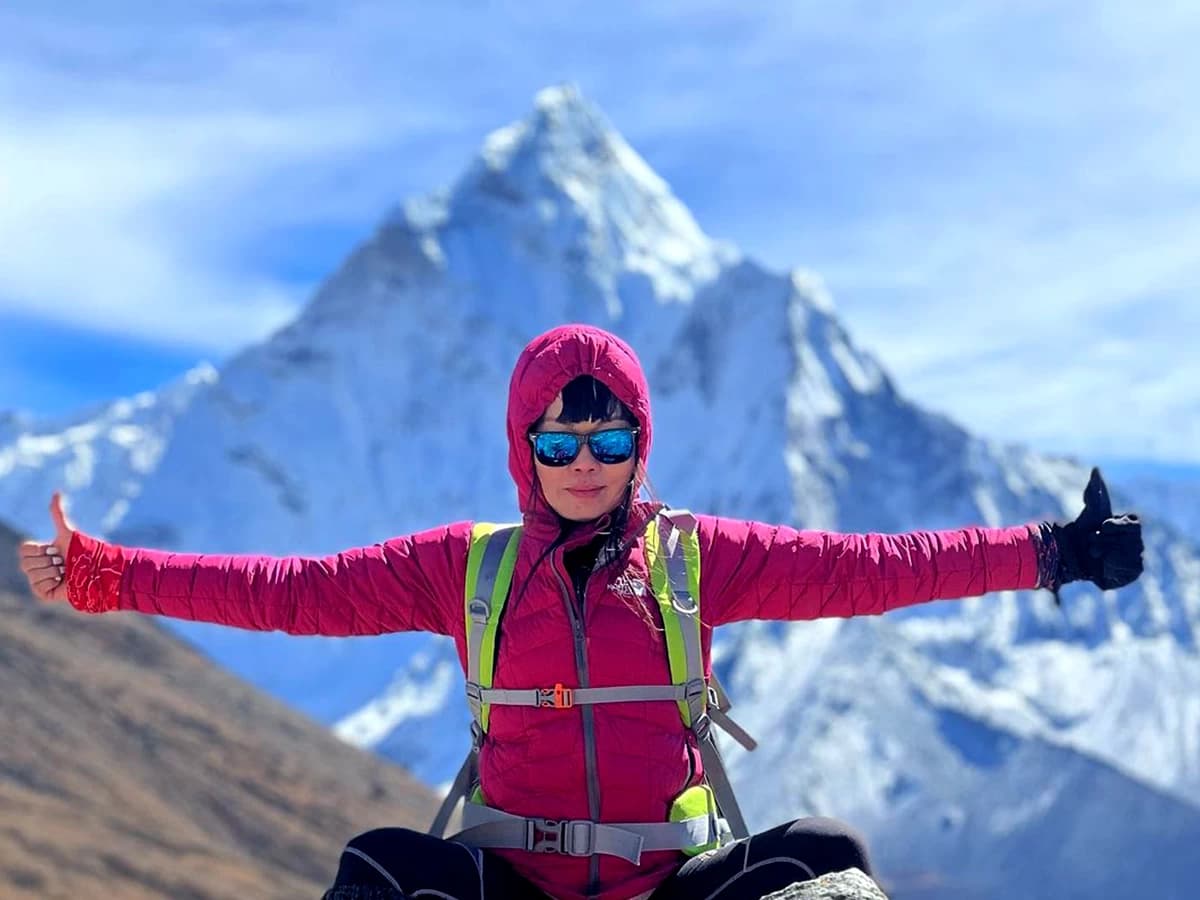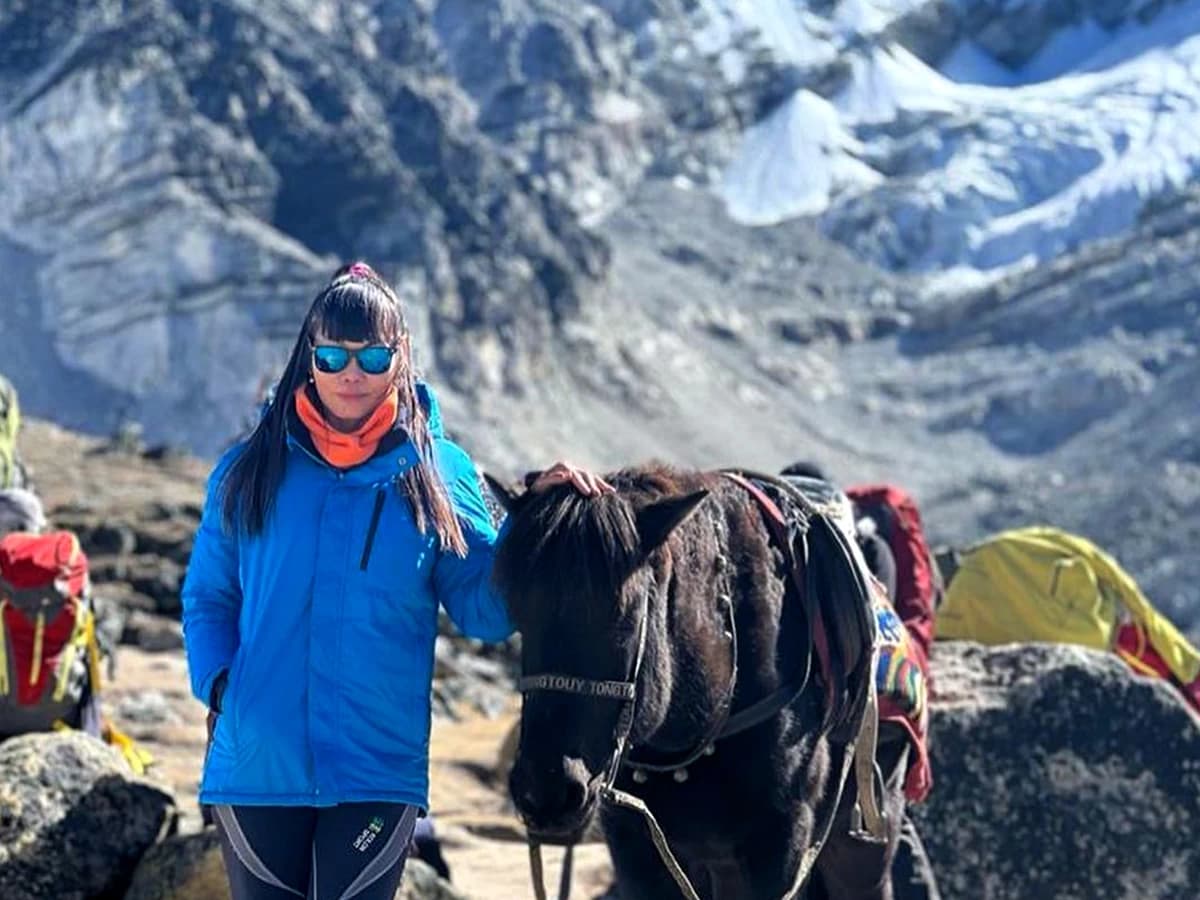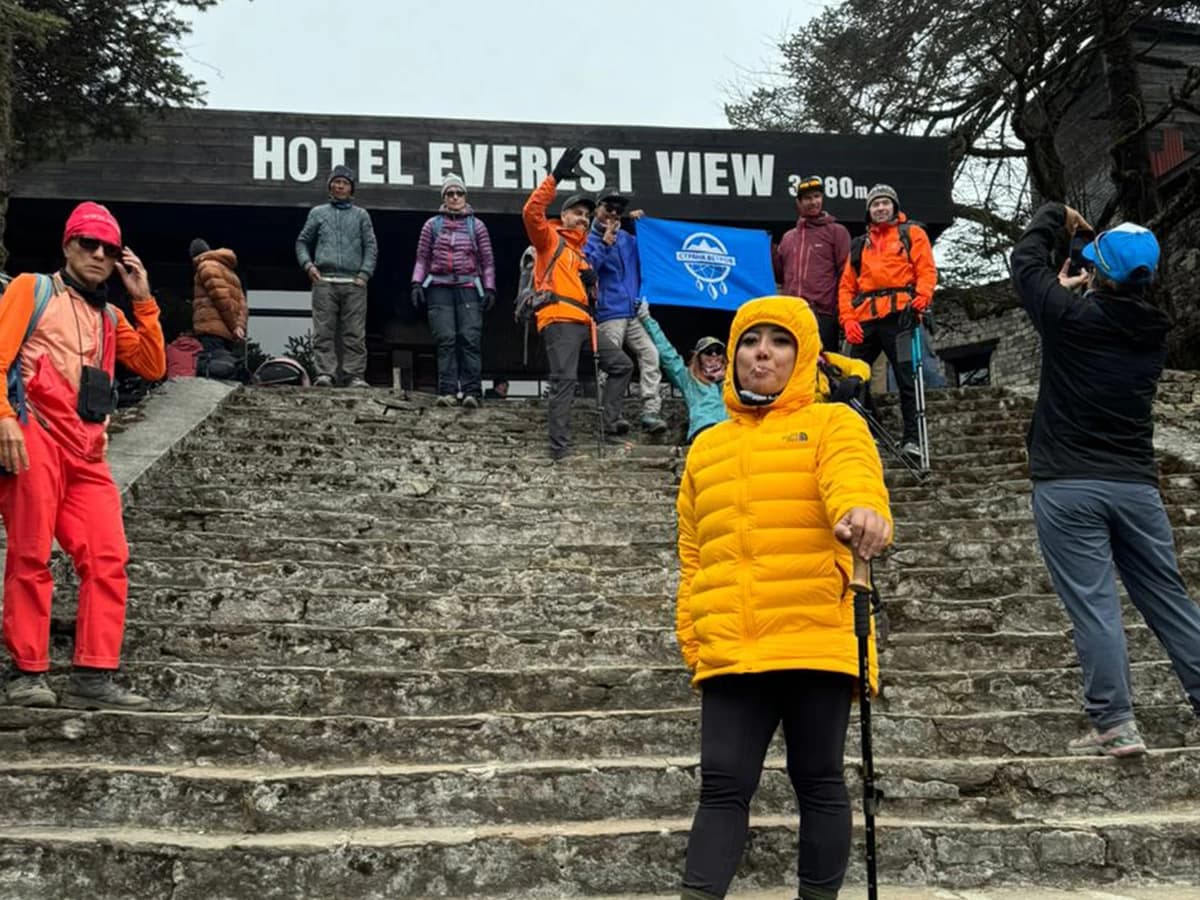“If you ask us to pick one trek in the Everest region, we will select the Everest Three High Passes trek as it covers the entire region. Imagine reaching heights and witnessing views that only a handful of humans get to live.”
The Everest Three High Passes trek is an adventurous high-altitude trek in the Everest region. The trek combines Everest Base Camp, Kala Patthar, Gokyo Lakes, untouched Thame village, and three high mountain passes above 5,000 meters. It is one of the longest treks in Nepal, and the journey is extraordinary.
You will be in the heart of the Himalayas, surrounded by a welcoming Sherpa community and giant snow-capped mountains. Regardless of all the destinations you will hike during the Everest Three High Passes trekking, crossing Renjo La, Cho La, and Kongma La passes are the main highlights of this venture.
We advise trekkers not to take this trek lightly. The three passes trek is, in fact, a very challenging trek that requires a high level of fitness and previous high altitude experience. The trek involves strenuous steep ascents and long days stretching up to nine hours.
Therefore, the 3 passes trek is ideal for physically and mentally strong trekkers who can push themselves endlessly to conquer this demanding trekking program. Trekkers looking for a daring once-in-a-lifetime kind of adventure will not be disappointed with the 3 high passes trek.
Everest Three High Passes trek- clockwise or anticlockwise, what's the difference?
The Everest 3 High Passes trek can be done clockwise or anticlockwise. Even though the destinations are the same in both directions, the route you will traverse determines the order in which you cross the passes.
Following a clockwise route, you will first cross Renjo La, then Cho La, and at last, Kongma La. In the anticlockwise route, you will first cross Kongma La, followed by Cho La and Renjo La.
On the Everest Three High Passes trek 19 days, you will trek in the anticlockwise direction, which is more popular and offers better acclimatization and easier logistics.
- Clockwise pass order - Renjo La → Cho La → Kongma La
- Anticlockwise pass order - Kongma La → Cho La → Renjo La
Key highlights of the Everest Three High Passes trek
The three high passes
Kongma La, Cho La, and Renjo La are three high mountain passes in the Khumbu region that connect different parts of the region. The ascent to these passes involves a steep climb to a high altitude. Therefore, trekkers need to be well-acclimatized before attempting the crossing due to the thin air.
- Kongma La pass: Kongma La pass is situated at 5,540 meters (18,176 ft). This is the first pass you will cross during the 3 pass trekking. To go from Chhukung village to Lobuche village, you will cross the Kongma La pass.
- Cho La pass: Cho La is the second pass you will cross. It is situated at 5,420 meters (17,782 ft) from sea level. This pass connects the Everest Base Camp area to Gokyo valley. The pass involves glacier crossing.
- Renjo La pass: Renjo La (5,360 m/17,585 ft) is the final pass you will cross on the Everest three pass trek. This pass connects Gokyo Valley with Thame and brings you back on the track to Namche Bazaar.
Major attractions along the trail
Namche Bazaar
Namche Bazaar is a vibrant and bustling market town, located in the Khumbu region. It is a popular stopover for trekkers and climbers heading to Mount Everest and other peaks in the eastern Himalayas, Nepal. At 3,440 meters (11,286 feet), Namche Bazaar serves as the cultural and economic hub for the Everest region.
Hotel Everest View and Chhukung Ri: acclimatization hikes
Hotel Everest View is located in the village of Syangboche, near Namche Bazaar. Located at 3,962 meters (13,000 feet), the Hotel Everest View is famous for providing comfortable and luxurious accommodations to trekkers. As the name suggests, Hotel Everest View offers breathtaking panoramic views of some of the world's highest peaks, including Mount Everest.
Chhukung Ri is located near the village of Chhukung. The ascent to the viewpoints allows trekkers to acclimate to the higher altitude before climbing Kongma La Pass. You will follow a steep, rocky route to reach Chhukung Ri. The views of Cho Oyu, Makalu, Cholatse, Ama Dablam, etc, are incredible from here.
Tengboche monastery, Pangboche monastery, and Thame monastery
Tengboche monastery, also known as Dawa Choling Gompa, is a Tibetan Buddhist monastery located in the Tengboche village at 3,867 meters (12,687 feet). Tengboche monastery is the biggest monastery in the Khumbu region and holds great spiritual significance for the local Sherpa community.
Pangboche monastery is another significant monastery located in the Pangboche village at 3,985 meters (13,074 feet). Pangboche Monastery is one of the oldest monasteries, with a history dating back several centuries. This monastery is famous for claiming to possess relics believed to be the skull and hand-bones of the mythical Yeti.
Thame Monastery is situated in the village of Thame, west of Namche Bazaar, at 3,800 meters (12,467 feet). Thame Monastery is deeply rooted in Sherpa culture and is known for its traditional Tibetan Buddhist architecture. Thame serves as a gateway to the Upper Khumbu region.
Gokyo Lakes and Gokyo Ri
Gokyo Lakes are a series of glacial holy lakes. They are renowned for their stunning beauty, surrounded by towering snow-capped peaks, including Cho Oyu and Everest. The Gokyo Lakes are among the world's highest freshwater lake systems, with the biggest lake, Dudh Pokhari, where the Gokyo village is located.
Likewise, Gokyo Ri is a viewpoint located near the village of Gokyo. From here, trekkers get to witness a stunning panorama of the Gokyo Lakes and Mount Everest. The sunrise and sunset views from Gokyo Ri are particularly spectacular.
Everest Base Camp and Kala Patthar
Everest Base Camp (EBC) is situated in the Khumbu region of Nepal, within the Sagarmatha National Park. It serves as the permanent base for climbers attempting to summit Mount Everest, the world's highest peak.
Situated at 5,364 meters (17,598 feet) above sea level, EBC is one of the most famous destinations in the Himalayas, where travelers from all around the world visit either by trekking or heli flight.
Kala Patthar is a viewpoint located near EBC. It is situated at 5,545 meters (18,192 feet) and offers breathtaking panoramic views of Mount Everest and the surrounding peaks. Because trekkers do not get to see the view of Mount Everest summit from its base camp, they hike to Kala Patthar to enjoy a direct close view of the summit of Everest.
How is the 3 passes trek compared to the Everest Base Camp trek?
Because most trekkers around the world know the Everest Base Camp (EBC) trek, we have compared the 3-pass trek to the EBC trek to provide a better understanding of this trek's difficulty, duration, what to expect, cost, etc.
| Trek features | Everest Three Passes trek | Everest Base Camp trek |
| Trek duration | 19 to 20 days | 12 to 16 days |
| Difficulty | Very challenging | Moderate to difficult |
| Previous trek experience | Must | Not required |
| How many times over 5,000 meters? | More than More than six times | Three times |
| Crowd | Balance of crowded mainstream EBC trail and peaceful trails | Mainstream EBC trail |
| Scenery | Varied scenery with lakes and jaw dropping panoramas from top of the passes | Diverse landscapes |
| Package cost range | USD 1,850 to USD 2,250 | USD 1,250 to USD 1,650 |
| Luxury lodge package range | Above USD 3,000 | Above USD 2,500 |
Highlights
- The ultimate adventurous high-altitude trek in the Everest region
- Experience thrilling Lukla flights and trek through rhododendron forests
- Hike to Everest Base Camp, Kala Patthar, Gokyo Lakes, and untouched Thame village
- Spend nights in simple lodges in the beautiful Sherpa villages
- Explore ancient monasteries like Tengboche and Thame
- Cross three high mountain passes above 5,000 meters
- Be in the heart of the Himalayas, surrounded by a welcoming Sherpa community
- Witness jaw-dropping mountain vistas and breathtaking landscapes
- Exciting side excursions to Hotel Everest View, Chhukung Ri, and Gokyo Ri
- Explore the stunning six Gokyo Lakes situated in the remote setting of Gokyo Valley
- Traverse glaciers, moraines, and rugged terrains
- Push yourself endlessly and break free from your bodily limits
- Enjoy the perfect balance of tranquil moments and memorable interactions with locals and fellow trekkers
Who should do the Everest Three High Passes trek 19 days?
The Everest Three High Passes trek is ideal for travelers who fit into the below categories. Note that fitness and past high-altitude experience are non-negotiable.
✅ Strong physical and mental fitness – Strenuous climbing, high altitude, and significant endurance demands.
✅ Experienced trekkers – Previous high-altitude trekking experience is a must.
✅ Adventure Seekers – For trekkers who want to travel beyond EBC and seeking in-depth exploration.
✅ Photography Enthusiasts – Unmatched Himalayan mountain panoramas, diverse landscapes, and stunning sunrises and sunsets.
❌ Not for Beginners
What will you get in our Everest Three High Passes trek package? What are the other expenses that trekkers should know about?
In our Everest Three High Passes trek package, you will get accommodation and breakfast in Kathmandu, trek permits, accommodation, three meals a day during trekking, a guide, and a porter. The company's service charge is also covered in the package cost.
The expenses not covered in the package cost are international flights to/from Kathmandu, travel insurance, trekking clothes and gear, tips, shopping, bar bills, lunch and dinner in Kathmandu, personal expenses, and Nepal travel visa.
*Note: All the services will be provided as per the itinerary. Any additional service will cost extra money.
How do you prepare for the Three High Passes trek?
Usually, if you do not come from a mountain village or town, you are not used to high altitudes and do not possess the required physical fitness to trek in the Himalayas. So, you have to prepare for yourself before joining any trek.
Preparation includes refining your physical strength and mental capabilities. Given the high difficulty and demands of Everest Three High Passes trekking, it is important that you are in good shape. Otherwise, the trek will become very unpleasant.
Follow the following tips to prepare for the Everest Three Passes trek:
- Strength training: You will carry a 5 kg daypack throughout the trek and walk on rugged terrain, so focus on strengthening your core, leg, and back muscles.
- Cardio and endurance training: 6 to 7 hours of uphill and downhill walking daily at high altitudes requires great stamina and endurance. Cardiovascular exercises like long walks, hiking, stair climbing, swimming, cycling, running, etc., will help you improve your strength and stamina.
- Acclimatization: If you can do a few day hikes or trek before starting 3 passes trek, it will help you a lot. In short, you have to be exposed to high altitude to join this trek. On our part, we have made the perfect Everest Three High Passes trek itinerary to provide easy acclimatization opportunities.
- Mental preparation: While training, you will naturally push your mental limits and become confident. In addition, you should also research the weather, temperatures, accommodation, meals, terrain, etc, on the three passes trek. It will make you mentally ready for the trip.
Why choose the Base Camp Trip for the 3 high passes trek?
- Get unmatched Everest Three High Passes trek cost and service with us.
- Flexible itinerary that you can customize to suit your requirements.
- Professional guide with a minimum of five years of expertise and local Sherpa porter.
- Complimentary airport pick-ups and drop-offs as per the itinerary.
- Free-of-cost duffel bag to use during the trek.
- Low-cost rental gear such as sleeping bags, trekking poles, down jackets, etc.
- Reliable management team, full logistic support, and sustainable travel.
- Transparent pricing and no hidden costs.
- Excellent booking and cancellation policy.
- Trek certificate.




